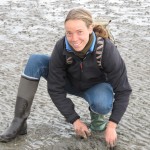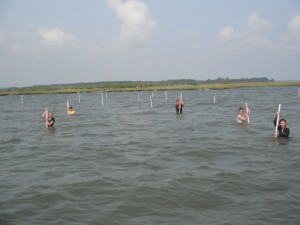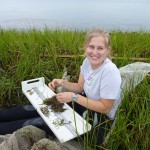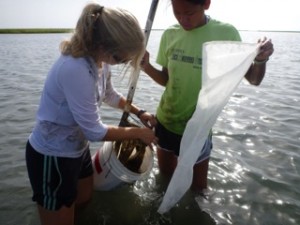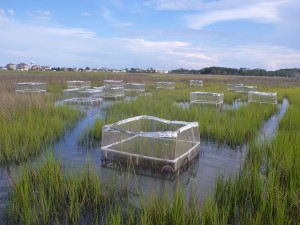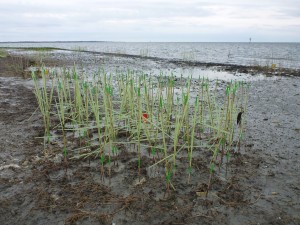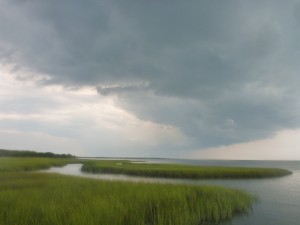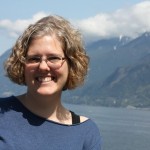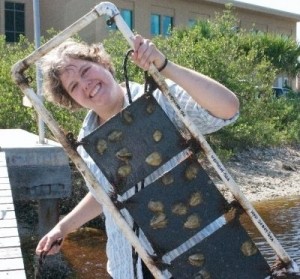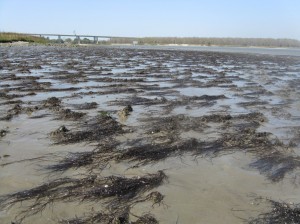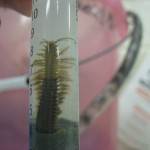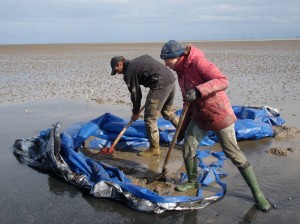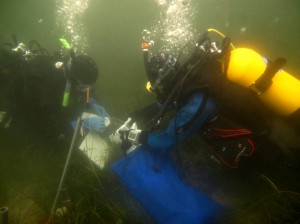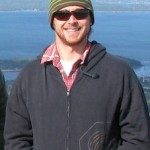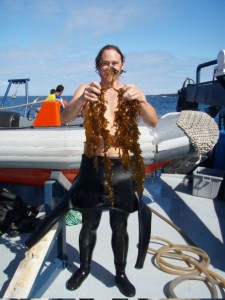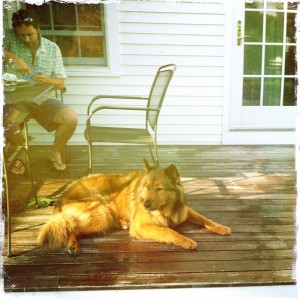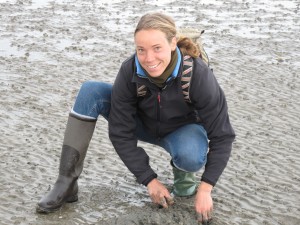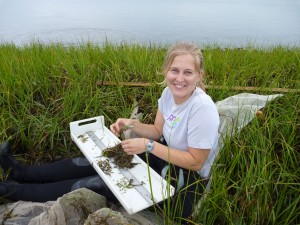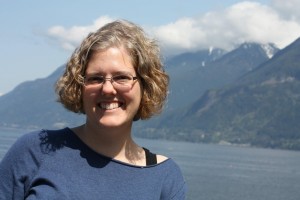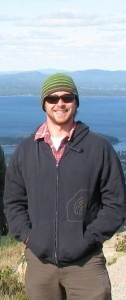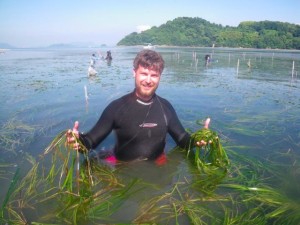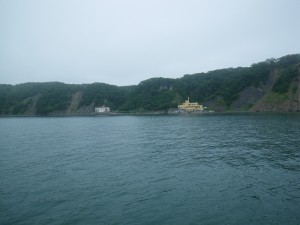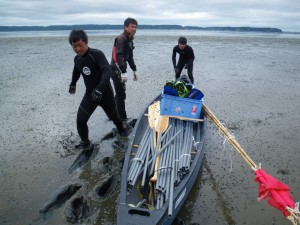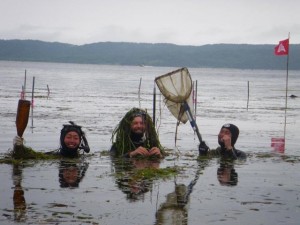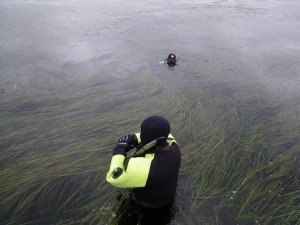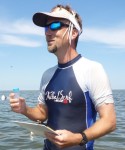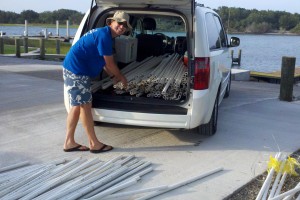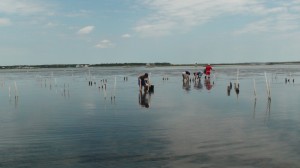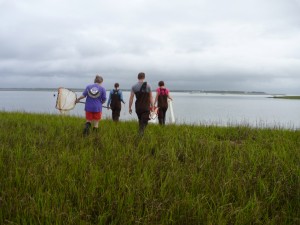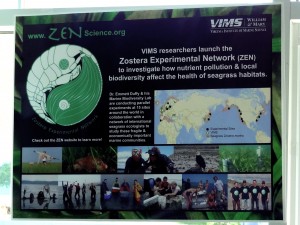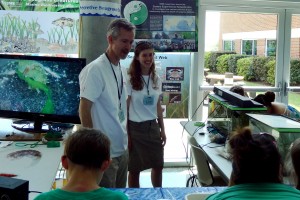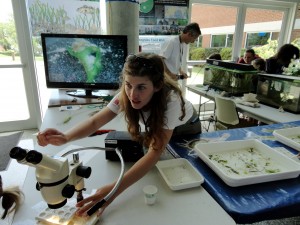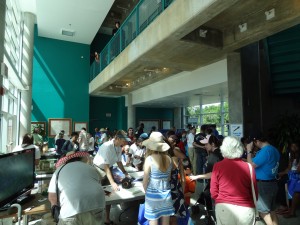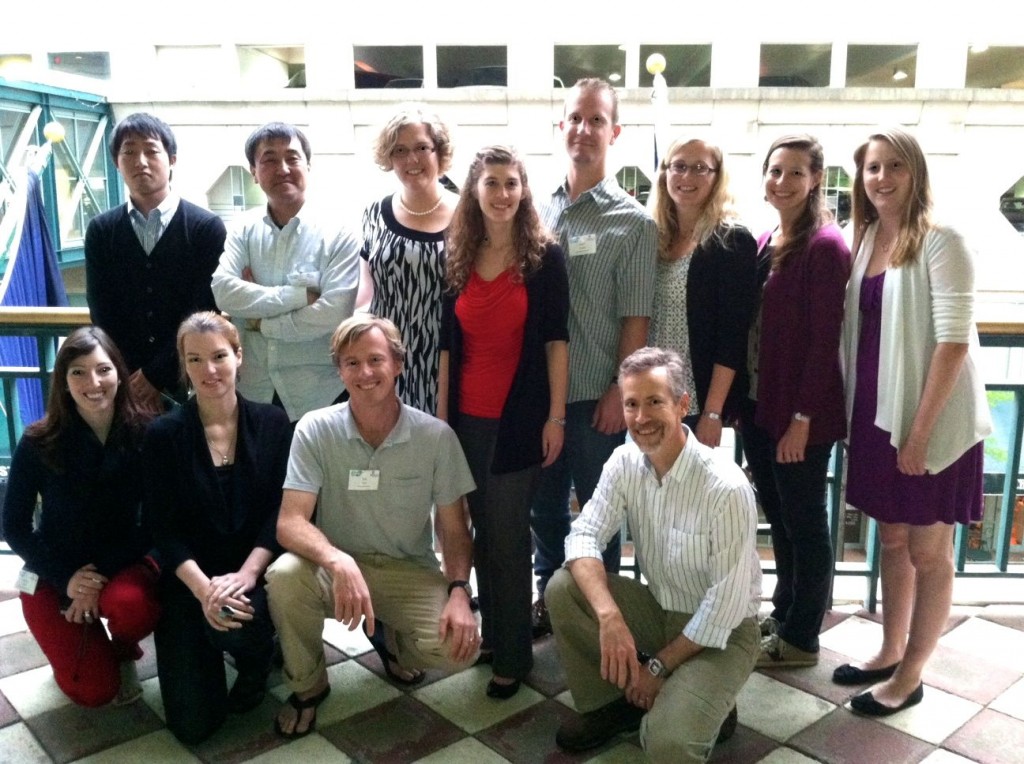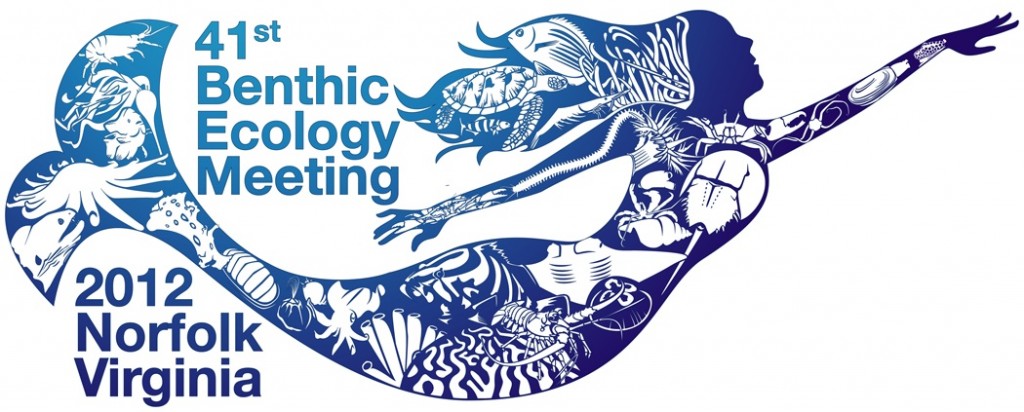Friendly people, stingrays and turtles: Welcome to Virginia
by Serena Donadi (ZEN exchange student fellow in Virginia)
My ZEN experience for 2012 has begun! Two weeks have already passed since my arrival at the Virginia Institute of Marine Science (VIMS) and here is my preliminary evaluation: great people, great place and great work!
First of all, I was impressed by the welcome and friendliness of the people, from my housemates to the VIMS’ stuff. The research group of Dr. Emmett Duffy is composed by graduate and undergraduate students along with apost-doc and technicians working on different projects. What’s really great is the high level of collaboration and interaction within the group. Fieldwork means hard work, limited time (the tides rule our schedule) and often adverse climate conditions (40 degrees Celsius!), and everybody knows that one person can make the difference to successfully reach the goals of the day. Helping each other is also the best way to get to know what other people are working on. Collaboration is the perfect recipe for a highly dynamic scientific environment, and the Marine Biodiversity Lab and others at VIMS are definitely a good example.
What a great place is the Chesapeake Bay! The experimental site of the ZEN experiments this summer is really beautiful. Dense beds of seagrass cover wide areas along the coast and are inhabited by an extremely rich community of organisms. The first day I saw the place I felt a bit like Alice in Wonderland. I put my hands into the dense seagrass bed and I found them covered by tens of giant (at least according to my experience) amphipods, isopods, gastropods… I jumped out of the boat and started walking. Blue crabs (even bigger than my hands!) were hiding everywhere and quickly moved away from my feet. Schools of silversides followed me, maybe attracted by the disturbance and the potential for an easy meal as my feet stirred up the sediment and associated invertebrates as I walked through the seagrass bed.
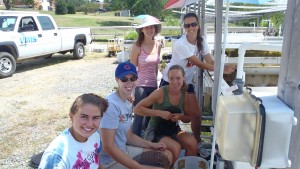
The women of the ZEN team in Virginia: undergraduates Nicole Rento, Caitlin Fikes and Katelyn Jenkins, graduate student Serena Donadi, and post doc Pamela Reynolds
After collecting myself from the marvel and the surrounding beauty, I helped my team with the tasks of the day: collecting seagrass shoots andepifaunal invertebrates, and catching and measuring mesograzer predators (small fish, crabs and shrimp). With 5 people, we managed to finish before the tide was too high and we jumped on the boat, ready to go back. As a perfect end to my first day of fieldwork, a sting ray swam elegantly in front of us and the head of a terrapin (a type of turtle) appeared at the surface . Maybe they were welcoming me to Virginia, or maybe they were just relieved that we retreating away from their home. I prefer to think it was the former.
Now that I’ve got my feet wet, I’m excited for what other adventures await me here in Virginia!
Meet ZEN student fellow, Rachel
by Rachel Gittman (ZEN exchange student fellow, Southern Japan site)
If someone told me this time last year that I would be traveling to Japan this summer to study amphipods and 3-meter tall Zostera marina, I wouldn’t have believed it. My reason for not believing such a scenario is not because I couldn’t see myself traveling to Japan, or because I didn’t think that seagrass could grow 3m tall, but because I couldn’t imagine studying amphipods. As a former lab mate of Dr. Pamela Reynolds, the post-doctoral researcher coordinating the ZEN project, I received an intense introduction to the world of mesograzers during my first year of graduate school. I swore to her that I would never study amphipods because they were just too small. Yet here I am, working with those amazing little crustaceans for the third consecutive year. I guess “never say never” is a lesson I have yet to learn.
Before I go further with my expectations for my encounters with Japanese amphipods this summer, here is some background on me. I am a third year PhD candidate in the Curriculum for the Environment and Ecology at the University of North Carolina at Chapel Hill’s Institute of Marine Sciences. My graduate advisors are Dr. John Bruno and Dr. Charles “Pete” Peterson. As a marine community ecologist, I am broadly interested in the biotic and abiotic factors that affect the structure and functioning of marine communities.
My dissertation work focuses on how two anthropogenic stressors, coastal development and sea level rise, can affect coastal habitats. More specifically, through fish community sampling and field experiments I evaluate how artificial shoreline stabilization and increased tidal inundation (a result of sea level rise) can affect the composition and persistence of coastal fish and invertebrate communities that utilize salt marsh, oyster reef, and seagrass habitats. My research often requires me to sample fish at night, trudge through dense, mosquito-infested marsh to survey the plant communities, and count and often tag many a periwinkle, fiddler crab, and other interesting marine invertebrate.
Life outside of graduate school
When I am not knee-deep in a muddy salt marsh collecting fish, I somehow manage to still enjoy being outside by running, swimming, kayaking, and walking my dogs. I also enjoy yoga, cooking, gardening, and just in case I don’t already sound a bit older than I actually am, even knitting. When I find the time to get away, I like to check out local music and restaurants, as well as escape a few times a year to the Appalachian Mountains to camp and hike.
Concern for habitat forming species unites us all
Although my dissertation work has a very different focus than the ZEN objectives, ultimately they both revolve around understanding the factors that affect the health and persistence of foundation species (e.g., the eelgrass Z. marina, marsh cordgrass Spartina alterniflora, and the eastern oyster Crassostrea virginica) that provide critical habitat for marine organisms. It is this parallel that first interested me in the ZEN project and continues to drive my participation in the network. I have been working with the ZEN partners as the North Carolina site coordinator since 2011. I am very excited to expand my participation in the ZEN project by traveling to both Hiroshima and Akkeshi, Japan, this summer to assist fellow researchers with this amazing project.
My primary expectation for this project is that I cannot know what to expect, which is very exciting. I imagine that the seagrass beds in Japan will be very different from those in North Carolina, which I am sure will pose unanticipated challenges, but also unexpected insights into the dynamic relationships between mesograzers, their predators, and the in-common foundation species Zostera. I am looking forward to working with the Japanese researchers and learning more about Japan’s ecosystems.
Meet ZEN student fellow, Nicole
by Nicole Kollars (ZEN exchange student fellow, Northern Japan site)
My name is Nicole and I am a Master’s student working with Dr. Erik Sotka at the College of Charleston in Charleston, South Carolina (USA). Erik first introduced me to the ZEN project at the North Carolina site earlier this summer and I am looking forward to continuing my experience with ZEN as a student fellow in Japan! I heard that the eelgrass there is up to a meter long (that’s over three feet!) and I can’t wait to see what else may be different (or the same) compared to the other ZEN site I’ve worked at, Middle Marsh, in North Carolina.
Growing up on both coasts
My family is from Minnesota and my parents moved back there a few years ago. I learned how to talk while in California, grew up in Washington State, and went to high school in Oklahoma. After graduating with my Bachelor’s in 2007 from Western Washington University, I lived in Florida, New York, and Oregon before landing in South Carolina for graduate school.
More about me...My favorite color is purple. When working at the fast food restaurant chain Wendy’s, I could make a junior bacon cheeseburger in 3.9 seconds. I swam varsity in high school. I took 9 years of piano lessons. I go a little crazy when given a blank canvas and oil pastels. I really don’t like scary movies or raw onions. Give me a head lamp and a midnight-low tide and I won’t stop smiling for a month!
The science of species invasions
I absolutely love science, especially marine critters. As a Master’s student, I am working with Erik and our collaborator, Dr. Jeb Byers at the University of Georgia, studying the ecological roles of the invasive red seaweed Gracilaria vermiculophylla in the mudflats of the southeastern US. My thesis research focuses on two aspects of this invasion: 1) tracking the invasion history of Gracilaria using a global population genetics approach (if anyone sees Gracilaria and is willing to send us samples please let me know!) and 2) investigating the nature of the relationship Gracilaria forms with a decorating tube worm (the polychaete, Diopatra cuprea).
Going to the ‘birthplace’ of an invasive marine algae
I have spent many a days covered head-to-toe in mud getting to know how Gracilaria looks, feels, and “behaves” in South Carolina, but I have no idea about the ins-and-outs of Gracilaria in its native habitat. How is it different, how is it the same? Well, it just so happens that the type locality for Gracilaria is in Akesshi Bay, Hokkaido, Japan! So I not only have the privilege of helping the ZEN partners in Japan but I also have this amazing opportunity to see Gracilaria in its home waters. It is most definitely a young marine ecologist’s dream come true.
It goes without saying that I am really stoked to go to Japan. I am excited not only to take advantage of the opportunity to learn all I can about native Gracilaria, but also to experience a new culture and a new eelgrass bed. I think the most challenging aspect of working in Japan will be the language barrier, but hopefully I will be able to pick up the basics quickly. I have a Japanese friend here in Charleston who is doing what she can to teach me the essentials. I’ll be boarding the plane to Japan with open expectations but I do hope to come back to Charleston with a new perspective on science and life. I’m looking forward to keeping everyone updated with what I learn, see, and experience as I explore the seagrasses and seaweeds of Japan.
Next time you hear from me, I’ll be in the land of Nihon!
Meet ZEN student fellow, Serena
by Serena Donadi (ZEN exchange student fellow in Virginia)
I was born in Italy 29 years ago. Potentially as a wish for the years to come, my parents called me Serena, which means something between calm, quiet, happy and optimistic. While I think I fit the latter two descriptors, I am much too active and energetic to ever be considered “calm and quiet.”
A childhood by the sea
I spent my childhood in a little town, close to the sea, in northeastern Italy. When I was one-year old, I brought home the first of what would become a long list of pets. It was a cockle (a little bivalve of sandy bottoms, specifically Chamelea galina), which I thoroughly looked after and fed with bread. That triggered the decision from my parents to get a cat. They couldn’t imagine that in a time span of few years, I could add rabbits, lemmings, birds, walking stick insects, beetles, snails, turtles, mice, guinea pigs, ants, bugs, fish, frogs, and more! We moved a few times, and every time my little animal community moved with me. I remember my mother driving a car filled with cages of little mammals and birds while my brother sat in the back seat holding bowls full of turtles and the fish in and I sat in the front I was taking care of my guinea pig Tommy (my favorite at that time), up worried that he would get car-sick.
The number of animals living with me decreased gradually over time (if we don’t count the hundreds walking sticks in my room) and become zero when I started my studies at the University of Trieste (North-East Italy). There I got my Bachelor’s degree in Natural Science and my Master’s degree in Marine Biology. During those years, I worked in Natural Parks in Portugal and Marine Protected Areas (MPAs) in Italy on butterflies, sea-urchins, and bivalves. My master’s thesis arose from my work with a multibeam echosounder (which is a scientific sonar) in the MPA of Miramare (Trieste, Italy), where we monitored fish population in artificial reef areas close to the coast to track changes in fish abundance over time.
From Italy to the Netherlands
One year after my master’s degree I started my PhD in the Netherlands. How did I end up in the flattest country in the world? I spent some time traveling in Europe and decided to try a PhD abroad. I started up my browser and I soon found the advertisement for a PhD position in the University of Groningen’s Department of Marine Benthic Ecology and Evolution. I liked what I saw and sent in an application. A few weeks later I received an invitation to go there for an interview. I was so terribly excited! On the 23rd of December 2009 I was shaking the hand of those who are now my supervisors and colleagues, Drs. Klemens Erickson and Jeanine Olsen. After the interviews, I went into town to skate on an ice rink in the main square and soaked up the Dutch culture. I didn’t imagine that I was going to spend 4 years of my life there! I was in a bookshop when my phone rang and I was told that I had been selected for the program. And then, the question: do you want the job? My brain didn’t react at all. I was simply too happy to start any rational thinking process. “Yes, of course I want it!” On the other side of the phone, I heard the voice asking me whether I needed a bit more time to think about it. But I was sure. It was a matter of feeling; good feelings for the people I had met, good feelings for the project, good feelings for the town. What a lucky fit!
PhD Research – secrets of the Dutch tidal flats
And here I am, raking in the mud to discover the secrets of the Dutch tidal flats. The main focus of my project is the role of ecosystem engineers (species that strongly modify physical characteristics of their habitat) on the mudflats of the Wadden Sea. Our target species are cockles, lugworms and mussels. We want to know how they affect sediment stability and what the consequences are of changes in sediment stability for the communities of organisms that live in this ecosystem. To address this question, we conducted a big field experiment where we added large quantities of cockles or lugworms to 25 m2 plots placed in muddy sites close to mussel beds or in sandy areas far from mussel beds. It was a lot of work, but also a lot of fun! After 3 years of hard fieldwork I have definitely become a mud-expert, in term of walking in the mud, crawling, raking, and digging.
Going collaborative – involvement in ZEN
Last year I was involved in the ZEN project at the Norway site. I helped with breaking down the experiment in one of the most remote and beautiful place I have ever seen – Bødo, Northern Norway. It was truly great: a new ecosystem to explore, an exciting experiment to carry out, a great team of people to work with. I couldn’t help but try to get involved again in this summer’s ZEN projects. And here I am, looking forward to traveling to the Virginia Institute of Marine Science (VIMS) in Virginia. I’d like to get the chance to thank those who made this possible, first among others: Pamela and Emmet (from VIMS), Klemens and Jeanine (from MARBEE, University of Groningen). What are my expectations? Less mud, warmer temperature hard work and a great time! I am looking forward to meeting the Virginia ZEN team and being on our way to Chesapeake Bay!
Meet ZEN student fellow, Max
by Max Overstrom-Coleman (ZEN student exchange fellow in Massachusetts)
My name is Max. I’m a PhD student at Dartmouth College in Hanover, New Hampshire USA studying seagrass ecology. I’ve always been interested in marine biology. When I saw my first Jacques Cousteau film I knew I wanted to dedicate myself to exploring life underwater. Certified to dive when I turned 13, I took my first job as a research diver when I was 16 and never looked back. After studying coral reef cleaning symbioses in the Yucatan Peninsula for my undergraduate thesis at the College of the Atlantic, I struck out for California and the great Pacific Ocean. There, I learned of the concept of a foundation species while researching the effect that kelp, algae from the order Laminariales that can form dense forests underwater, has on both the physical and biological structure of an ecosystem. Foundation species are “a single species that defines much of the structure of a community by creating locally stable conditions for other species, and by modulating and stabilizing fundamental ecosystem processes” (Paul Dayton 1972).
Habitat forming species give life to underwater landscapes
I quickly developed a love for these habitat-forming species and I was intrigued by their influence on animal communities. That interest drove my research at Moss Landing Marine Laboratories, where I earned a master’s degree in marine science under Dr. Michael Graham. Having returned to the East Coast and the ocean I was first introduced to, the intrigue of foundational species continues to motivate my PhD research at Dartmouth College. I currently study how foundation species affect their associated communities, particularly the mechanisms influencing the role of Zostera marina (eelgrass). As with kelps, the presence of eelgrass drastically alters the physical environment and provides essential habitat for a diverse community of plants and animals. Eelgrasses influence these communities via their leaves, which provide substrate for epiphytic algae as well as offering small crustaceans, gastropods and fishes refuge from predation. These interactions are important because epiphytes are known to fuel these coastal food-webs and the refuge offered to small animals that eat epiphytes is thought to positively influence the growth of the seagrass itself.
Unfortunately, a pattern has recently emerged: seagrasses are in decline in New England and globally. The loss of seagrass populations and reductions in their density can have community-wide consequences including loss of commercially important species. My research is aimed at understanding how reduced eelgrass density affects epiphytes and the animals that depend on them. This summer I am excited to learn more about eelgrass and the role they play in structuring the communities that exist in the habitat they provide. My participation in the ZEN project will allow me to work in an eelgrass bed in Nahant, Massachusetts, help me to understand what is important for eelgrass growth and persistence and investigate what happens when it declines or is lost from a system.
Outside my life as a marine scientist
I currently live in Thetford, VT with my fantastic wife Amanda and our wonder-dog Jackson. We live on about 4 acres of land. When I am not working on the coast or studying at Dartmouth you will find me rock climbing, hiking with Jackson or working on our house/land. My recent projects include reclaiming an old apple orchard and re-siding our barn. I am especially excited about the orchard because it looks like we can expect moderate production this year (200-300 gallons) and it to increase thereafter (over 1,000 gallons next year)! Our other project for the summer are to replace our decrepit porch with a structurally sound deck on which we can enjoy BBQs and the cool night air.
Meet the ZEN exchange student fellows!
This summer we have four outstanding graduate students traveling to different ZEN partner sites. These ZEN “exchange student fellows” will be assisting with all aspects of the research at their host sites, from fieldwork to labwork, and in the process learning new research skills and about the local culture. See below for a quick synopsis about each of our four student fellows and stay tuned as they will be writing periodic posts about their experiences throughout the summer.
Serena Donadi is a PhD student at the University of Groningen in the Netherlands advised by Drs. Klemens Eriksson and Jeanine Olsen. Serena assisted with the ZEN experiment at the Northern Norway (NN) site last summer. She is working at the ZEN site in Virginia this summer. Her dissertation research examines the role of mudflat ecosystem engineers (cockels, lugworms, mussels) on sediment stability and the structure of the benthic community in the Wadden Sea.
Rachel Gittman is a PhD student at UNC-Chapel Hill working at the Institute of Marine Sciences in Morehead City, North Carolina, USA, advised by Drs. John Bruno and Pete Peterson. She was the local contact and helped with the ZEN experiments in North Carolina both last and this year. She will be working with Dr. Masakazu Hori at the southern Japan site (JS) and assisting with projects at the northern Japan site (JN) starting at the end of July. For her dissertation, Rachel is studying the effects of shoreline development on functioning in salt marsh and seagrass habitats in coastal North Carolina in addition to exploring food web interactions in these systems.
Nicole Kollars is a master’s student at the College of Charleston in Charleston, South Carolina, USA, advised by Dr. Erik Sotka. She assisted with the ZEN experiment in North Carolina (NC) this summer and will be working with Dr. Massa Nakaoka at the northern Japan (JN) site starting at the end of July. Nicole’s master’s research focuses on the ecological roles of the invasive red seaweed Gracilaria vermiculophylla in the mudflats of the southeastern USA.
Maxwell Overstrom-Coleman is a PhD student at Dartmouth University in Hanover, New Hampshire, USA, advised by Dr. Brad Taylor. He recently started working at the ZEN site in Massachusetts with Dr. James Douglass. Max’s dissertation work focuses on the role of eelgrass as foundation species and their effects on abiotic habitat parameters in estuaries in the northeastern USA.
First Seagrass to see the light (part 2)
by Matt Whalen (VIMS, PhD student at UC Davis)
As I was gearing up for this year’s ZEN experiment in Bodega Bay, CA, I realized that I never finished my story from last year’s experiments in Japan. (Where does all the time go?) Hopefully this belated entry will be a nice way to kick off the 2012 ZEN season.
“Banzai, banzai, banzai!” was one of the first things I heard as my father and I watched the sun rise over the top of Mt. Fuji. It was a long journey—especially if you count my childhood memories of my father’s stories of Japan and his promise that we would one day climb to the top of the iconic mountain—but it was well worth it. There is a saying that goes something like, “You would be a fool not to climb Mt. Fuji, but you would be an even bigger fool to do it twice.” Well, my momma didn’t raise no fool. I really enjoyed that hike and I’m proud to have completed it with my dad, who was only a year out of knee replacement surgery, but the mile-long conga line of hikers ascending just before sunrise made me wish for the relative isolation of many U.S. National Park peaks. This side trip with my dad marked a transition between ZEN experiments and the halfway point in my journey to Japan.
Up north, to the land of Sapporo and snow
The next stage of my ZEN adventure took me to the northern island of Hokkaido, which is far less populous than the ‘main island’ of Honshu and home to the large city and brewery of Sapporo. I was immediately struck at how different this place looked compared to Hiroshima. The architecture was more rustic and functional; the Japanese-style tile roofs of the south gave way to A-frame metallic roofs in Hokkaido with increased seasonality and snow fall in the north. The countryside was also more bucolic in a western sense, with acres of cattle pasture mixed with stretches of corn and soy. It actually bore a striking resemblance to parts of Virginia, where my ZEN adventure began.
My new digs were at the Akkeshi Marine Station just outside of the important fishing town of Akkeshi. Seated at the base of steep cliffs, the laboratory, dormitory, and flagship research vessel were the only manmade structures in sight for a large stretch of the coastline. The coast here bends inward forming the large Akkeshi Bay. On clear mornings, I could easily see the other side of the bay and wisps of inland mountains further in the distance. The bay leads to Akkeshi town, ending in the narrow entrance to an estuary that is nearly as large as the bay itself.
Because it is almost completely enclosed, this estuary is referred to as a lake (Akkeshiko), but it is influenced by the tides throughout its extent and freshwater input comes largely from a single river. The lake is famous for its oysters and, more recently, Manila clams. More importantly for me, it has amazing meadows of seagrass. Nearly the entire estuary is covered with eelgrass whose leaves can grow over two meters in length (that’s over 6 feet!). When boating from one side of the lake to the other, it is necessary to stop and throw the motor in reverse every few hundred meters because the prop gets tangled in seagrass. On the plus side, with each subsequent field trip, we created a channel of sorts from all the lawn mowing and were able to minimize our impacts by following it all the way to our field site.
Unexpected challenges
For this node of the ZEN network, we faced a few challenges. The first challenge was the commute, which either involved a mowing expedition though the eelgrass meadow in a small motorboat or a half-hour drive to the far side of the lake where canoes could be launched in knee deep mud. This later choice was substantially slower but the drive took us through some gorgeous woods where we were ever vigilant for brown bears, which were often seen in those parts (not by any of us, fortunately or unfortunately!). If the potential threat of bears wasn’t enough to hurry us into the water, the clouds of mosquitoes surely helped us shave off a few minutes from the commute. I leave Virginia to fly halfway around the world and still found myself chased by the winged menaces!
The second challenge was the physical labor involved with field work in such tall eelgrass. Our site was fairly deep, such that at low tide the water came up to just above my waist. With eelgrass well over a meter tall, this made movement between plots as slow as molasses and reduced visibility to the front of our dive masks. I’m used to working in low visibility water in Virginia, but the ribbon-like eelgrass tangling everything was a new beast entirely. We were constantly brushing eelgrass out of our faces while surveying or sampling. And, when we came up for air, we often had wads of grass tugging our snorkels out of our mouths and “Cousin It” inspired eelgrass hairdos. Needless to say, we had to take great care to not rip the eelgrass from the inside of plots or brush off the very epiphytes we were aiming to quantify.
Never judge a jelly by its size
The final challenge made for one of my more memorable and culturally engaging experiences during my time in Japan. It concerned an eelgrass critter that had also visited me on occasion in Hiroshima, a small jelly that densely occupied the ZEN site in Lake Akkeshi. They pack a pretty mild punch (it wouldn’t come close to a box jelly), but when you get stung repeatedly it can take a toll. I experienced some of the pain in Hiroshima, a sharp sting and a long-lasting dull ache, but I wasn’t prepared for Lake Akkeshi.
We were finishing up some work on the weekend, so travel to the field site required both car and canoe. All was going smoothly, my Japanese collaborators and I by this point worked like a well oiled machine. That is, until I unintentionally swallowed some water stuck in my snorkel. Intense stinging in my mouth – that’s what I remember first. I spat and spat, but the stinging did not go away. Next my esophagus was on fire, and then my lower back and most of my joints began to ache. It was a deep ache, down to the bones, that made it hard to move or even think. I had swallowed part of a tiny jelly!
Luckily, I was surrounded by my new friends who loaded me back into the canoe and took me to shore. It took multiple canoe trips to get all the gear and people back to shore so I had to wait on the mudflat in between trips, still in my wetsuit since the mosquitoes were too bad to do anything else. Foundering in the mud with the stinging pain reaching a new peak, I vaguely remember hoping that this was not my day to finally see a brown bear. How I must have looked like an injured seal, covered in dark neoprene and writing in the mud! The decision was made to take me to the hospital, to which I couldn’t object by this time. I was largely incapacitated.
It was quite a while before we made it to the hospital, but I am happy to say that the experience was relatively easy. They had no problem treating me without my passport, and Dr. Hori (the project leader in Hiroshima) stayed with me to translate. To be honest, there was not much treatment that could be offered, although I was given some medicine to ease the pain. I was sent home with a goody bag of prescriptions that I needed more help translating, but I remained restless with pain. It took me another full day to recover completely. On Monday, I returned to the hospital to pay my bill, which was surprisingly modest. Luckily, after a handful of awkward and borderline comical exchanges about worker’s compensation back in the US, I was reimbursed in full. Being a marine ecologist does has its hazards, but I can’t think of anything else I’d rather do.
Jellyfishing in Japan, a short movie made by Matt Whalen based on his encounters with jellies in Japan.
The beauty of it all
All in all, ZEN in Hokkaido was an amazing experience. The eelgrass system there is so full of life. When viewed underwater, the meadow looks more like a forest and, if you are patient and a little lucky, many of the creatures that thrive under the canopy come into view. Small mysid ‘shrimp’ are very abundant here and seem to be important grazers on algae that grow on eelgrass leaves. There are also many abundant species of fish that presumably eat a lot of those mysids and other small grazers. And, of course, there are the jellies. They are actually quite beautiful when you don’t have thousands of nematocysts (their harpoon-like stingers) firing into your tissues!
Mysids on Eelgrass Akkeshi, a short movie by Matt Whalen.
I am so thankful for the opportunity to be a member of the ZEN Japan team during 2011. The country and its people left many lasting impressions on me, and I yearn to go back. Hopefully now that I am based on the West Coast of the USA I will have more opportunities to collaborate with the colleagues and friends I made on my adventure. There are two graduate students traveling to Japan this summer to participate in round two of the Zostera Experimental Network (look for their posts from Japan this summer!) and I hope to live vicariously through them as they travel and conduct experiments. I will be keeping up with their stories from Bodega Bay, CA, where our excellent team has just finished installing a major component of this year’s experiment. I can’t wait to hear about how things go at the other sites and to make more ZEN memories this summer. Dewa mata!
Road trip to North Carolina
by Paul Richardson (VIMS technician)
photos by Pamela Reynolds (ZEN coordinator)
The road trip begins!
On Friday, June 1, 2012 undergraduate student Katelyn Jenkins and I loaded up a fancy Ford F-150 rental truck with filters, jars, vacuum pumps, and neoprene and set out for The University of North Carolina’s at Chapel Hill’s Institute of Marine Sciences (UNC-IMS) in Morehead City, North Carolina to help Erik Sotka’s (College of Charleston) group break down this summer’s main ZEN experiment. It was a marathon of work, but the good company, nice scenery, rocking tunes, and Oreo cookie snacks made the time fly. We amassed a large group for the effort. Erik’s graduate students, Nicole Kollars and Courtney Gerstenmeier, and his REU intern, Aaron joined Katelyn and me along with UNC-IMS local, Alyssa Popowich to comprise a formidable experimental breakdown team.
Katelyn and I arrived a bit earlier on Friday than the South Carolina contingent, so we helped Alyssa prepare tin envelopes that are used for drying samples in the lab. This prep work was a key task and streamlined the next two days. After helping Alyssa, we grabbed a quick dinner in town and then met up with Erik’s crew. As with any major experimental endeavor, a trip to the store was necessary for last minute supplies which this time included hundreds of Ziploc bags for collecting and storing field samples.
Rocking out in the field and the lab
This was our first major ZEN experiment event in North Carolina without the presence of Pamela Reynolds, the ZEN coordinator, which made us all a bit nervous, but her and Erik’s extensive planning paid off and this was an extremely efficient and productive experimental breakdown. I really enjoyed working with Erik and his crew. Everyone was so positive and they all had an unyielding work ethic. I also learned something interesting about Erik when I asked about the band that he played in back when he was in graduate school. Pamela tipped me off to this fact but she was vague on the details. When I asked Erik, he said it was his only “brush with fame” when he played with the band Cake before they were big. Wow, what a huge ‘brush’! I love Cake. As you may know, Cake is a talented rock band from Sacramento, California with a keystone trumpeter, Vince DiFiori. As Erik said, “Cake would not be Cake without the trumpet,” and I agree! But, during Cake’s embryonic stage they experimented with other wind instruments which included Erik on the saxophone. In another universe, Erik is a music rock star. In this universe, he has to settle with being a marine ecology rock star. Tough break.
Luckily Aaron brought his iPod loaded with thousands of great songs, which kept things lively in the lab as we processed samples. I know it sounds like I’m getting off track here, but good music is essential for tedious long stretches of labwork!
Never a boring moment
One thing that we didn’t do was go sightseeing. Before we left Pamela told me that I should check out some of the various parks andbeaches, (including Fort Macon) if I had the time. While we didn’t have any extra time for sightseeing (I’ll save that for a family vacation) I did see plenty of pretty sights during the course of our field work. Carrot Island on the right and the town of Beaufort on our left made for nice scenery as we motored out to the field site in a local Carolina skiff. A short boat ride towards the inlet brought us to the field site in the Rachel Carson Reserve, which is adjacent to a gorgeous system of Spartina marsh islands called Middle Marsh.
Comparing Virginia and North Carolina
At first glance, the marine environment of Bogue Sound appears similar to the Chesapeake Bay but a critical eye will notice some striking differences. The most conspicuous difference that I noticed was the abundance of intertidal oyster reefs. We had to traverse one to get to our seagrass bed. We used to have numerous oyster reefs in the Chesapeake, but overfishing and disease have had their toll and they have yet to recover. Another interesting comparison was the abundance of sea urchins and brittle stars at Middle Marsh. These animals are rarely, if at all, found in the York River and western side of the Chesapeake Bay, but were all over the place at Middle Marsh. I even saw an urchin hanging out in the middle of one of our experimental plots!
Tiny drifters make fieldwork challenging
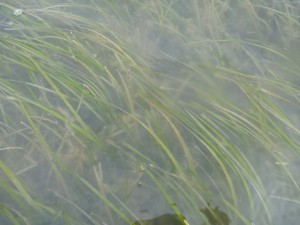
Eelgrass at the ZEN field site in Middle Marsh, North Carolina is home to many marine invertebrates, some benign and others best left undisturbed
Another less exciting difference between the VA and NC ZEN sites was the abundance of hydroids (small jellies). As soon as I waded into the knee deep water and began admiring the lush bed of the eelgrass Zostera marina, a stinging sensation spread along my legs. By the end of the day we were all envious of Nicole, who was smart enough to wear knee high neoprene boots. Although it wasn’t as sharp as a bee sting or even your standard sea nettle, the thoroughness of stung surface area did give the mild sensation that the flesh was melting off of my legs. This was especially true when I showered with fresh water that first night and any remaining unengaged nematocysts (the specialized cells jellies sting you with) exploded into my skin. I’m just glad the water was only knee deep! Alyssa and Pamela warned me about this, but it was too hot to wear a wetsuit and I didn’t have an appropriate dive skin. But, I wasn’t the only one, so there was plenty of camaraderie. The stinging took a few days to go away – a not so pleasant reminder of an otherwise enjoyable experimental breakdown!
Wrapping up
Sunday was another marathon, but this time in the lab. We processed seagrass shoots and scraped off the epibionts (animals and plants living on them), and sorted and preserved the associated mesograzers along with other field samples. We split into two teams to divide and conquer! Except for a short lunch break, we went full tilt until, suddenly, it was 7pm. With the fieldwork completed, lab samples processed, and the local lab somewhat straightened up, we packed up our gear and hit the road. What we planned to take us four days we completed in two. We made it back to Virginia a little before midnight and I slept like a rock. The sun, salt and intense fun of fieldwork will always be my preferred sleeping pill!
ZEN at Marine Science Day 2012
by Pamela Reynolds (ZEN coordinator)
We introduced the Zostera Experimental Network to the public of Virginia at the tenth annual Marine Science Day (MSD) event at the Virginia Institute of Marine Science (VIMS) in May, 2012. Over 2,000 people visited the VIMS campus in Gloucester Point, VA for a full day of behind-the-scenes learning about marine science and the Chesapeake Bay.
Our Marine Biodiversity Lab ran an touch tank exhibit titled “Secretive Seagrass Creatures” where kids and adults had up close encounters with mesograzers and the fish, crabs and shrimp that live in local seagrass habitats. We even hooked up a high definition video camera to one of our microscopes so everyone could watch an amphipod graze on algae and make a mucus tube.
The public was very receptive and inquisitive, especially regarding the ZEN.
Questions we were frequently asked:
Q. What do you mean everyone at the different ZEN field sites did the same experiment?
A. We shipped boxes of experimental materials and sent copies of a detailed protocol (a “how to” guide book), along with instructional videos, to all of the other scientists to ensure that everyone used the same methods. The videos were great as not all of the participating students from the other countries spoke fluent English.
Q. How can you compare the Chesapeake to somewhere like Norway or Alaska? Isn’t it colder up there?
A. Yes, it most definitely is! And this variability, or differences in environmental conditions such as temperature and salinity, is very important. By having a range of environmental conditions, we have more power to understand how these factors such as being in a colder or warmer place can affect the important seagrass communities we are studying.
Q. How do you know these mesograzers are important? They’re really small. Don’t turtles, herbivorous fish and other larger marine animals eat more?
A. Although mesograzers such as amphipods are small, they can eat a lot of algae, especially the algae that grows on the leaves of seagrass and competes with the seagrass for light and nutrients. We have conducted many experiments in tanks and have found that mesograzers can do a good job at keeping the seagrass clean and promoting its growth. While turtles and fish may have larger mouths and take bigger bites of algae, they aren’t necessarily eating the same types of algae or the algae growing on the seagrass, and these larger herbivores aren’t found all over the world. Mesograzers, however, are everywhere and can be very abundant. If you grab a big handful of seagrass in the Chesapeake you can catch hundreds of amphipods!
Q. I live near the Chesapeake. Why should I care about seagrass in Japan or Sweden?
A. By studying other places we can understand how regional and global issues such as pollution, overfishing and seawater warming can threaten our local systems. Oceans make up about 70% of the Earth, and most of them are connected. If we only study the Chesapeake, we loose a valuable opportunity to help understand and predict future challenges.
Our one shortcoming from this year’s Marine Science Day – no one dressed up like an amphipod or other mesograzer for the annual Parade of Marine Life, although while cleaning up our lab we did find a child-sized Idotea (a type of marine isopod) costume from years past. Next time!
ZEN at the 2012 Benthic Ecology Meeting
The Zostera Experimental Network (ZEN) team formally emerged into public view for the first time at the Benthic Ecology Meeting this past week in Norfolk, Virginia. ZEN coordinator Dr. Pamela Reynolds (top center in the photo, in red) presented a first look at the results of our 2011 experiment evaluating the relative importance of grazing, nutrient loading, and abiotic forcing on dynamics of eelgrass (Zostera marina) communities across the Northern Hemisphere.
ZEN had representation from several of our 15 global sites, and a diverse group of PIs, grad students and undergrads, at BEM this year. These included teams from northern Japan (PI Massa Nakaoka and grad student Kyosuke Momota), Quebec (graduate students Julie Lemieux and Laetitia Joseph), Massachusetts (PI James Douglass), North Carolina (PI Erik Sotka, grad students Rachel Gittman and Nicole Kollars, technicians Danielle Abbey and Alyssa Popowich), and Virginia (Emmett Duffy, Pamela Reynolds, Paul Richardson).
The abstract of Pamela’s presentation:
A comparative-experimental approach reveals complex forcing among bottom-up and top-down processes in seagrass communities across the Northern Hemisphere
Pamela L. Reynolds (1); Emmett Duffy (1); Christoffer Boström (2); James Coyer (3); Mathieu Cusson (4); James Douglass (5); Johan Eklöf (6); Aschwin Engelen (7); Klemens Eriksson (3); Stein Fredriksen (8); Lars Gamfeldt (6); Masakazu Hori (9); Kevin Hovel (10); Katrin Iken (11); Per-Olav Moksnes (6); Masahiro Nakaoka (12); Mary O’Connor (13); Jeanine Olsen (3); Paul Richardson (1); Jennifer Ruesink (14); Erik Sotka (15); Jay Stachowicz (16); Jonas Thormar (8)
(1) Virginia Institute of Marine Science, (2) Åbo Akademi University, (3) University of Gronigen, (4) Université du Québec à Chicoutimi, (5) Northeastern University, (6) University of Gothenburg, (7) Universidade do Algarve, (8) University of Oslo, (9) Fisheries Research Agency, Japan, (10) San Diego State University, (11) University of Alaska Fairbanks, (12) Hokkaido University, (13) University of British Columbia, (14) University of Washington, (15) College of Charleston, (16) University of California Davis
Two fundamental challenges to prediction in ecology are complexity and idiosyncrasy. How do we evaluate the importance and generality of multiple, interacting factors in mediating ecological structure and processes? One promising way forward is the comparative-experimental approach, integrating standardized experiments with observational data. In summer 2011 the Zostera Experimental Network (ZEN), a collaboration among ecologists across 15 Northern Hemisphere sites, initiated parallel field experiments exploring bottom-up and top-down control in eelgrass (Zostera marina) communities. Eelgrass is among the most widespread marine plants, forming ecologically and economically important but threatened coastal habitats. We factorially added nutrients and excluded small crustaceans (mesograzers) using a degradable chemical deterrent for four weeks, and measured responses of associated plant and animal communities. As expected, results varied strongly across the global range. Our cage-free deterrent strongly reduced crustacean grazers; at several sites grazer exclusion released blooms of epiphytic algae and/or sessile invertebrates. In Chesapeake Bay, these blooms reduced eelgrass biomass after eight weeks, demonstrating mutualistic dependence between eelgrass and mesograzers. Surprisingly, nutrient addition had little effect on epiphytes, except in Massachusetts and Sweden where grazers are suppressed by mesopredators. Ongoing research is analyzing the relative influence of grazer diversity and environmental forcing in mediating these processes.
Analysis of the 2011 experiments is still under way–even as we swing into high gear for planning the 2012 experiment. We will be presenting the complete results of the 2011 experiment at the Ecological Society of America meeting in Portland (August 2012) and the 47th European Marine Biology Symposium in Arendal, Norway (September 2012). We hope to see you at one or another of these events!

